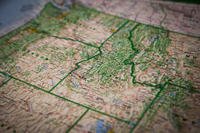I went to the grocery store today, and I nearly passed out at the cost of things. Food is getting more expensive every day. When you're on a tight budget, those higher food costs can really hurt. Thankfully, there are some ways you can probably stretch your food budget just a little further.
Eat What You Have
Start by planning meals around what's already in your pantry and freezer. See how long you can go without grocery shopping, except for fresh produce. Use the internet to find good ideas for the ingredients you already have on hand.
Plan Your Meals
Make a meal plan and grocery list before you start shopping. Incorporate as many pantry and freezer items as possible, then only buy the items that you need.
Eat Cheap!
The internet is awash in inexpensive meal suggestions and low-cost recipes. You can find suggestions to fit most diets. It's not all beans and rice (but beans and rice is super-cheap and gets the job done!).
Find One Low-Cost Solution
Pick one of your family's favorite meals and figure out ways to lower the cost. For example, make taco meat with half beef and half ground chicken, or half beef and half lentils. Or learn how to make your own taco seasoning or tortillas.
Once you've mastered one meal, start working on another meal.
Cut Back on Snacks and Drinks, But Plan for Them
Many families discover that they spend a huge portion of their food bill on snacks and beverages. Find low-cost substitutes or just cut back in general. A bag of popcorn to be popped on the stove costs very little and makes a ton. Water flavored with lemon and lime slices can be super-refreshing. You don't have to give up everything, but figure out what doesn't actually give you that much joy.
But don't plan to cut out snacks entirely. This can backfire and result in unplanned purchases between grocery store trips.
Use Basic Cleaning Supplies
Most cleaning can be done using simple ingredients like baking soda, vinegar and elbow grease. Use the internet to find cheap and natural solutions to tougher cleaning challenges. Avoid overpriced, prepared cleaning solutions whenever possible.
Choose Lower-Cost Stores
Most areas have stores that are known for lower costs. In my area, it used to be Shoppers Food Warehouse, but now Aldi and Lidl are the big winners. I do most of my shopping at Aldi and save at least 30% over the prices at the traditional grocery stores.
Use the Commissary Strategically
If you live close enough to a commissary to use it without wasting a tank of gas, get to know which items are cheapest. For my family, there are a few things that are better deals at the commissary, including meat and chicken. We stock up on the things that are better prices when we are already in the area.
Women, Infants and Children Program
The Special Supplemental Nutrition Program for Women, Infants and Children, usually called WIC, is an income-based program to provide nutritious foods. Eligible WIC participants include pregnant women, breastfeeding women, non-breastfeeding postpartum women, infants, toddlers and children up to age 5.
Supplemental Nutrition Assistance Program
The Supplemental Nutrition Assistance Program, also called SNAP, used to be called food stamps. It provides financial assistance to buy nutritious foods. Eligibility is based on income. You can apply for SNAP benefits through your state or local office.
Food Banks and Food Pantries
Your military installation or civilian community has some sort of food bank, somewhere. If you're not sure where to look, call your base family service center (Army Community Service, Airman and Family Readiness Center, Fleet and Family Support Center or Marine Corps Community Services) or the installation chapel.
Using some or all of these strategies can help you trim your food budget and keep your overall finances in line despite increasing food costs.
















